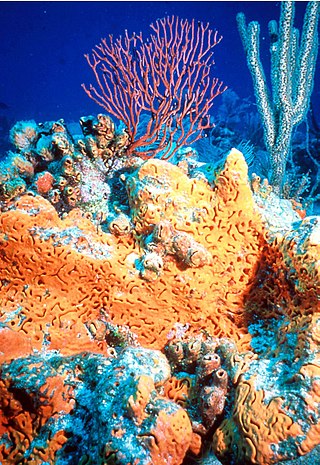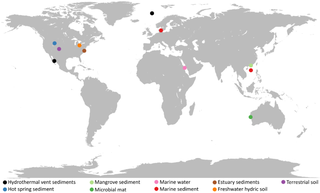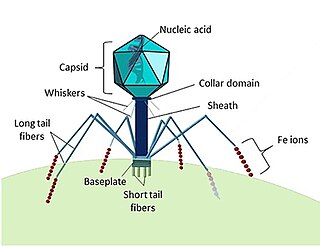
A genetically modified organism (GMO) is any organism whose genetic material has been altered using genetic engineering techniques. The exact definition of a genetically modified organism and what constitutes genetic engineering varies, with the most common being an organism altered in a way that "does not occur naturally by mating and/or natural recombination". A wide variety of organisms have been genetically modified (GM), including animals, plants, and microorganisms.
Plant disease epidemiology is the study of disease in plant populations. Much like diseases of humans and other animals, plant diseases occur due to pathogens such as bacteria, viruses, fungi, oomycetes, nematodes, phytoplasmas, protozoa, and parasitic plants. Plant disease epidemiologists strive for an understanding of the cause and effects of disease and develop strategies to intervene in situations where crop losses may occur. Destructive and non-destructive methods are used to detect diseases in plants. Additionally, understanding the responses of the immune system in plants will further benefit and limit the loss of crops. Typically successful intervention will lead to a low enough level of disease to be acceptable, depending upon the value of the crop.

A Vavilov center or center of origin is a geographical area where a group of organisms, either domesticated or wild, first developed its distinctive properties. They are also considered centers of diversity. Centers of origin were first identified in 1924 by Nikolai Vavilov.

The Blue Revolution refers to the significant growth and intensification of global aquaculture production—domestication and farming of fish, shellfish, and aquatic plants—from the middle of the 20th century to the present, particularly in underdeveloped countries. The peak and subsequent stagnation of capture fishery production in the late 1980s spurred technological innovation and improved efficiency for aquaculture production.
The viriome of a habitat or environment is the total virus content within it. A viriome may relate to the viruses that inhabit a multicellular organism as well as the phages that are residing inside bacteria and archaea.

In particle physics, the Glashow resonance is the resonant formation of the W boson in antineutrino-electron collisions:
ν
e +
e−
→
W−
.
The Network of Cancer Genes (NCG) is a freely accessible web resource of genes that, when altered in their sequence, drive clonal expansion of normal tissues or cancer. The project was launched in 2010 and has reached its 7th release in 2022. In 2023 the additional annotation of cancer drivers that interact with the tumour immune microenvironment was added. NCG7.1 reports information on 3,347 cancer drivers and 95 healthy drivers. Of these, 596 are also TIME drivers. NCG7.1 also reports the system-level properties and the associated publications of each driver, as well as a list possible false positives. NCG7.1 enables advanced searches on the primary anatomical site, cancer type, type of sequencing screens and literature supports.

Podiates are a proposed clade containing the Amorphea and the organisms now assigned to the clade CRuMs. Ancyromonadida does not appear to have emerged in this grouping. Sarcomastigota is a proposed subkingdom that includes all the podiates that are not animals or fungi. Sulcozoa is a proposed phylum within Sarcomastigota that does not include the phyla Amoebozoa (clade) and Choanozoa (paraphyletic), i.e. it includes the proposed subphyla Apusozoa and Varisulca
Biotechnology risk is a form of existential risk from biological sources, such as genetically engineered biological agents. The release of such high-consequence pathogens could be
Rosamond (Roz) Lee Naylor is an American economist focused on global food security and sustainable agriculture. She is the William Wrigley Professor of the Stanford University School of Earth System Science, and the founding Director of the Center on Food Security and the Environment at Stanford University. Her academic career has centered on environmental science and policy related to global food systems and food security. She is the President of the Board of Directors of the Aspen Global Change Institute, a Fellow of the Ecological Society of America, and a member of the Forest Protection Advisory Panel for Cargill.

Asgard or Asgardarchaeota is a proposed superphylum consisting of a group of archaea that contain eukaryotic signature proteins. It appears that the eukaryotes, the domain that contains the animals, plants, and fungi, emerged within the Asgard, in a branch containing the Heimdallarchaeota. This supports the two-domain system of classification over the three-domain system.

This is a list of several significant scientific events that occurred or were scheduled to occur in 2021.
Prime editing is a 'search-and-replace' genome editing technology in molecular biology by which the genome of living organisms may be modified. The technology directly writes new genetic information into a targeted DNA site. It uses a fusion protein, consisting of a catalytically impaired Cas9 endonuclease fused to an engineered reverse transcriptase enzyme, and a prime editing guide RNA (pegRNA), capable of identifying the target site and providing the new genetic information to replace the target DNA nucleotides. It mediates targeted insertions, deletions, and base-to-base conversions without the need for double strand breaks (DSBs) or donor DNA templates.

Marine viruses are defined by their habitat as viruses that are found in marine environments, that is, in the saltwater of seas or oceans or the brackish water of coastal estuaries. Viruses are small infectious agents that can only replicate inside the living cells of a host organism, because they need the replication machinery of the host to do so. They can infect all types of life forms, from animals and plants to microorganisms, including bacteria and archaea.
Bat coronavirus RaTG13 is a SARS-like betacoronavirus identified in the droppings of the horseshoe bat Rhinolophus affinis. It was discovered in 2013 in bat droppings from a mining cave near the town of Tongguan in Mojiang county in Yunnan, China. In February 2020, it was identified as the closest known relative of SARS-CoV-2, the virus that causes COVID-19, sharing 96.1% nucleotide identity. However, in 2022, scientists found three closer matches in bats found 530 km south, in Feuang, Laos, designated as BANAL-52, BANAL-103 and BANAL-236.
This article lists a number of significant events in science that have occurred in the first quarter of 2021.
Noam Slonim is an Israeli computer scientist, specializing in Natural Language Processing and Computational Argumentation. He is an IBM Distinguished Engineer, and the Principal Investigator of Project Debater at the IBM Research lab at Haifa, Israel.

Brevirostruavis is a genus of Early Cretaceous enenatiornithine bird from the Early Cretaceous Jiufotang Formation of Liaoning, China. The type and only species is Brevirostruavis macrohyoideus.
Debbie Lindell is the Dresner Chair in life sciences and medicine at Technion - Israel Institute of Technology. She is known for her work on the interactions between viruses and their hosts in marine environments.
Trevor Lawley FMedSci is a Faculty member and Group Leader in the Host-Microbiota Interactions Lab at the Wellcome Sanger Institute (WSI). He is also co-founder and Chief Scientific Officer of the biotech company Microbiotica.








